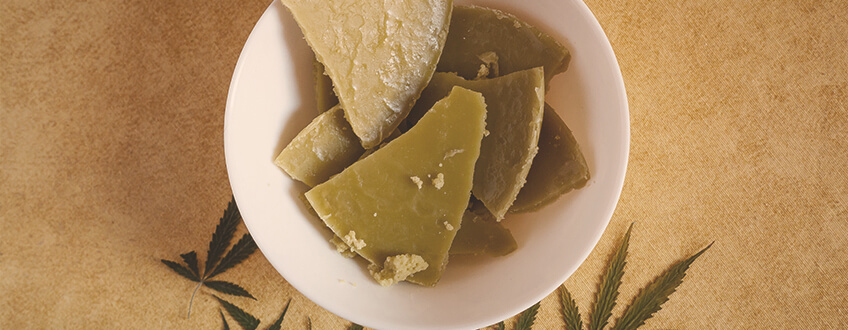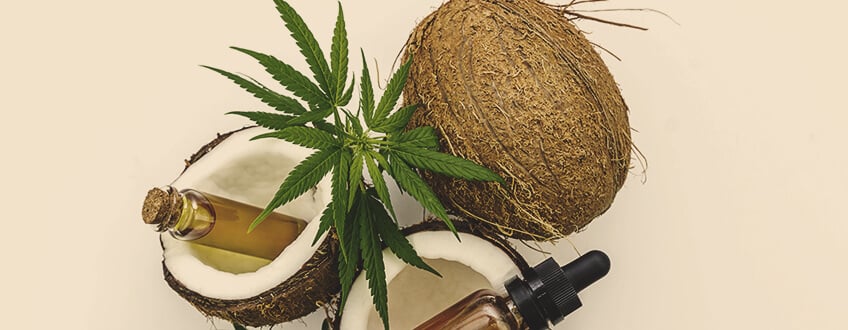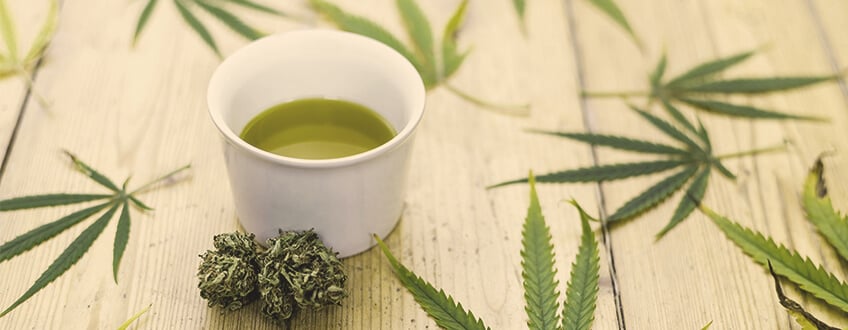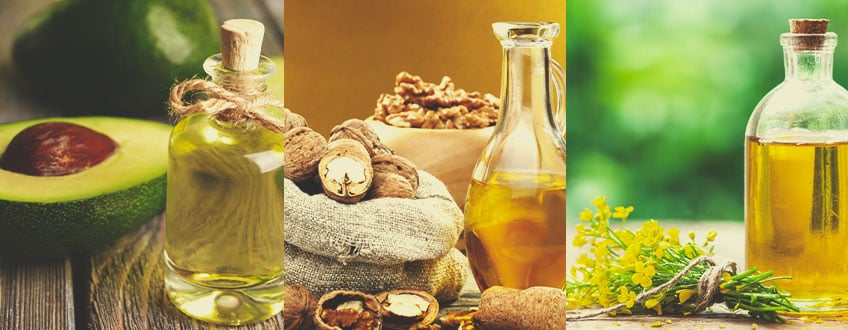.

Cannabutter vs Infused Oil: Understanding The Differences
Cannabutter is a weed chef's biggest weapon. But there are many other ways to infuse your meals with cannabis, such as trading in high-fat butter for coconut oil, olive oil, and more.
Contents:
Edibles offer an exciting way to enjoy the effects of cannabis. And while people usually think of cookies or brownies when they hear mention of edibles, there are many different ways to infuse your meals with cannabis. Keep reading for an overview of cannabutter and various types of cannabis oil—the foundation of most edibles—to see which option is right for you!
WHY USE CANNABUTTER?
Ahhh, butter. Nothing really compares to the sweet, rich flavor of quality butter made from full-fat milk. Couple it with some top-shelf Kush and you’ve got yourself a delicious way to infuse your favorite meals with cannabis.
Cannabutter is the backbone of brownies, space cakes, and cookies. It is made by cooking cannabis flowers in butter and water for anywhere between 3 and 24 hours, depending on the recipe. This process extracts cannabinoids and other compounds, such as beneficial terpenes and flavonoids, from the flower's trichomes into the butter. It is this process that makes them accessible to the body when we eat our edibles. Just remember to keep temperatures low as you simmer your butter to avoid burning it and destroying the precious compounds in your weed.
For really active butter, it’s always important to decarboxylate your weed first, which involves grinding and baking it for 30–40 minutes at low temperatures (roughly 110°C). Doing this helps convert cannabinoid acids, like THCA and CBDA, into their non-acidic active counterparts (THC and CBD), ensuring more potent edibles.
ADVANTAGES OF CANNABUTTER
Cannabutter is easy to make and complements both sweet and savoury dishes with its rich, buttery goodness. You can use cannabutter as a last-minute addition to creamy curries, as the base for scrumptious cookie dough, or even just smear it on the insides of a simple grilled cheese sandwich. Cannabutter is usually where most beginner weed chefs start their long, psychoactive journey with homemade edibles.
• Easy to make
• Flavorful
• Works in sweet and savoury dishes
• Relatively inexpensive
• High fat content supports potent edibles
DISADVANTAGES OF CANNABUTTER
Although butter is rich in vitamins and minerals, the main downside to cannabutter is its fat and dairy content. If you’re watching your fat intake, are vegan, or are intolerant to dairy, using cannabutter simply isn’t an option for you when it comes to making edibles. Luckily, that’s where cannabis coconut oil can save the day! Keep in mind that butter also has a low smoke point; high heat can spoil the flavor and effect of your edibles.
• Not the healthiest option for some
• Non-vegan
• Low smoke point

WHY USE CANNABIS-INFUSED COCONUT OIL?
Coconut oil is a source of many medium-chain triglycerides that are easy for your body to digest and use as energy. Studies also suggest that coconut oil may help promote heart health, help your body burn fat, and much more, making it a great alternative to regular cooking fats like butter and vegetable oils.
Infusing coconut oil is simple: Just cook some cannabis flowers and/or trim in oil and water for anywhere between 8 and 24 hours, depending on the recipe and the potency you’re looking for. Like when making cannabutter, it’s important you keep your temperatures low (to avoid destroying cannabinoids and burning your fat) and decarboxylate your flowers beforehand for a more potent finished product.
ADVANTAGES OF CANNABIS-INFUSED COCONUT OIL
As we mentioned earlier, coconut oil has a ton of benefits as a cooking oil, making it a healthy way to infuse your favorite dishes. The fact that some coconut oils don’t have a strong flavor makes them ideal for cooking everything from sweet treats to savoury delights. And if you’re looking to spice things up in the bedroom, you can also use infused coconut oil as a natural lubricant! Remember, THC is a natural vasodilator, and applying it to your skin can help direct blood flow to all the right places.
• Highly nutritious
• Vegan
• Versatile fat source (works in sweet and savoury dishes)
• Can also be used as a lubricant and general topical
DISADVANTAGES OF CANNABIS-INFUSED COCONUT OIL
There aren’t many serious disadvantages to using coconut oil, especially given its health benefits. For one, coconut oil doesn’t provide the same creamy texture and rich flavor to your meals that butter does. But whether that’s an issue or not really comes down to your eating habits, dietary requirements, and preferences. If you’re looking to infuse a batch of brownies, you might want to opt for cannabutter. On the other hand, if you want to infuse a healthy stir fry, coconut oil is likely the way to go.
• Less flavorful than butter
• Sometimes harder to access
• More expensive than butter

WHY USE CANNABIS-INFUSED OLIVE OIL?
If you’re looking for a cheaper, but still healthy, alternative to coconut oil, olive oil is your best bet. It has a delicious flavor that goes great in Mediterranean dishes, sprinkled over salads, dips, or even just some freshly baked sourdough (are you drooling yet?).
The process of making infused olive oil is exactly the same as infusing coconut oil.
ADVANTAGES OF CANNABIS-INFUSED OLIVE OIL
First, olive oil burns at a lower temperature than other cooking oils, meaning it shouldn’t be used for anything cooked on high heat (like steaks or stir fry). It’s also notably more accessible, both in terms of availability and price, than some of the other oils mentioned on this list. Plus, olive oil has a ton of health benefits: It’s rich in monounsaturated fats and antioxidants and hasn’t been associated with weight gain or obesity (unlike other cooking fats).
• Mild, pleasant flavor
• Nutritious
• Great for savoury dishes
• Easy to access
• More price/quality options
DISADVANTAGES OF CANNABIS-INFUSED OLIVE OIL
There are two main disadvantages to using olive oil as the base of your cannabis oil. First and foremost, olive oil burns at a lower temperature than other cooking oils, meaning it shouldn’t be used for anything cooked on high heat (like steaks or stir fry). Secondly, the strong flavor of olive doesn’t pair well with some dishes, such as sweets or desserts.
• Low smoke point
• Not ideal for sweet edibles
• “Nicer” olive oil is pricey

WHAT OTHER OILS CAN YOU USE TO MAKE CANNABIS EDIBLES?
Coconut oil, olive oil, and butter are far from your only options when it comes to making edibles. If you have the time, money, and weed supply, consider infusing some of the following oils to boost the variety in your kitchen.
AVOCADO OIL
• Almost 70% of avocado oil consists of oleic acid, a super healthy omega-9 fatty acid.
• Avocado oil has been shown to effectively increase HDL[1] (“good cholesterol”) in animals.
• Avocado oil is rich in antioxidants.
• Avocado oil may help the body better absorb nutrients[2] like carotenoids from food.
WALNUT OIL
• Walnut oil has a deliciously rich and nutty flavor that goes great in salads, pestos, and dips.
• Walnut oil is rich in antioxidants.
• Substituting walnut oil for other cooking oils may help decrease LDL cholesterol levels.
• Walnut oil is good for the hair and skin.
RAPESEED OIL
• Rapeseed oil is rich in antioxidants and vitamin E.
• Thanks to its high smoke point, rapeseed oil is great for cooking dishes on high heat.
• Rapeseed oil is low in saturated fats and contains no trans fat.
• Unlike some other cooking fats, most rapeseed oil is non-GMO.

WHICH IS STRONGER, CANNABUTTER OR CANNA-OIL?
A major concern when picking a lipid to use for cannabis cooking is how effective it is at absorbing THC and other cannabinoids from your weed. To deal with this dilemma, High Times author Elise McDonough made different cannabis infusions and sent them off for lab testing to see which yielded the most THC.
Based on testing by SC Labs and C4 Laboratories, clarified butter, coconut oil, and olive oil yielded the best results. Still, McDonough mentions that more study is needed to expound upon and confirm these findings.
HOW TO CHOOSE THE RIGHT FAT FOR CANNABIS EDIBLES
About to hit the kitchen and not sure which oil you should be infusing? Here are three factors to keep in mind to help you narrow down the choices.
POTENCY
If your top concern is cooking up the most mind-bogglingly potent edibles possible, you’ll want to choose a cooking fat with the highest absorption rate of THC and other cannabinoids. In that case, follow the findings by McDonough mentioned above and opt for clarified butter.
FLAVOR
Besides getting you baked, you obviously want your edibles to taste great. Keep that in mind when choosing an oil to infuse, and consider infusing two or three different oils to give you some variety. That way, if you decide to host a multiple-course dinner party for your friends, you can use certain oils for the savoury dishes and butter for the desserts (with a vegan coconut oil option, of course).
TEXTURE
Like flavor, texture is a huge part of how we experience food. Whatever dish you’re cooking, make sure to think about how your oil will influence texture and “mouthfeel”. Most oils have a similar texture; butter and ghee, on the other hand, have very unique textures that’ll go great in some dishes and completely change others.
- Cholesterol Vehicle in Experimental Atherosclerosis 24: Avocado Oil - PubMed https://pubmed.ncbi.nlm.nih.gov
- Carotenoid Absorption From Salad and Salsa by Humans Is Enhanced by the Addition of Avocado or Avocado Oil - PubMed https://pubmed.ncbi.nlm.nih.gov






































